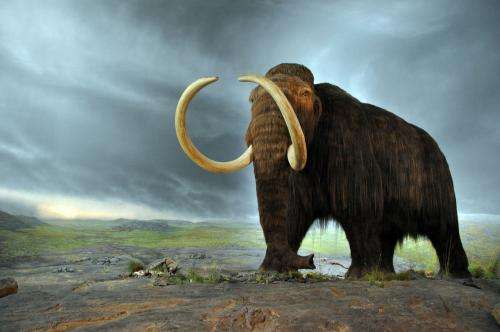Model at the Royal BC Museum. Credit: Wikipedia
(Phys.org)—A trio of researchers with Universidad de la República in Uruguay has found evidence that suggests the huge size of some animals during the Pleistocene may have been one of the contributing factors to their extinction. In their paper published in the journal Biology Letters, Angel Segura, Richard Fariña and Matías Arim describe their analysis of the major food webs during the Pleistocene in the Americas and its possible impact on megafauna.
Several types of large animals roamed the plains of the Americas during the Pleistocene—a period from approximately 2 million years ago to approximately 10,000 years ago, but most of them went extinct for still unknown reasons. Some researchers have concluded that humans wiped them out, others have suggested that it might have been due to disease, or because of a comet or asteroid striking. Others yet have suggested it might have been due to climate change—the researchers with this new effort have added more evidence to this last theory by undertaking a study of the food web that likely existed at the time before and during the extinction period.
In looking at the food web, the researchers focused on two main features: Trophic (relating to food and/or nutritional needs) and how vulnerable animals were to predation. In mapping a wide variety of animals of all sizes on a chart using data from the two features, the team found a bell shape forming, where the large sized animals existed on the hump—that suggested they were much more vulnerable to changes in their food supply.
To get an idea of how things might have been, the researchers noted that modern animals, like elephants require 165 to 330 pounds of food every day, and they live in a warm environment. Mammoths would likely have required more to keep warm, as would others, such as the large sabre-toothed cats. On the other hand, the largest animals likely did not have to worry too much about being attacked by predators, thus, it appears likely that their large size and appetite led to their downfall—as climate conditions led to less and less range for such beasts, they found it more and more difficult to fulfill their nutritional requirements—those that could not adept, went extinct.
More information: Angel M. Segura et al. Exceptional body sizes but typical trophic structure in a Pleistocene food web, Biology Letters (2016). DOI: 10.1098/rsbl.2016.0228
Abstract
In this study, we focused on the exceptionally large mammals inhabiting the Americas during the Quaternary period and the paramount role of body size in species ecology. We evaluated two main features of Pleistocene food webs: the relationship between body size and (i) trophic position and (ii) vulnerability to predation. Despite the large range of species sizes, we found a hump-shaped relationship between trophic position and body size. We also found a negative trend in species vulnerability similar to that observed in modern faunas. The largest species lived near the boundary of energetic constraints, such that any shift in resource availability could drive these species to extinction. Our results reinforce several features of megafauna ecology: (i) the negative relationship between trophic position and body size implies that large-sized species were particularly vulnerable to changes in energetic support; (ii) living close to energetic imbalance could favour the incorporation of additional energy sources, for example, a transition from a herbivorous to a scavenging diet in the largest species (e.g. Megatherium) and (iii) the interactions and structure of Quaternary megafauna communities were shaped by similar forces to those shaping modern fauna communities.
Journal information: Biology Letters
© 2016 Phys.org
























